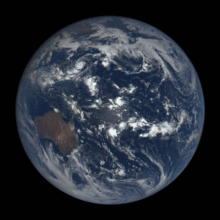
Earth's rotation or Earth's spin is the rotation of planet Earth around its own axis, as well as changes in the orientation of the rotation axis in space. Earth rotates eastward, in prograde motion. As viewed from the northern polar star Polaris, Earth turns counterclockwise.
The North Pole, also known as the Geographic North Pole or Terrestrial North Pole, is the point in the Northern Hemisphere where Earth's axis of rotation meets its surface. This point is distinct from Earth's North Magnetic Pole. The South Pole is the other point where Earth's axis of rotation intersects its surface, in Antarctica.
Earth rotates once in about 24 hours with respect to the Sun, but once every 23 hours, 56 minutes and 4 seconds with respect to other distant stars (see below). Earth's rotation is slowing slightly with time; thus, a day was shorter in the past. This is due to the tidal effects the Moon has on Earth's rotation. Atomic clocks show that the modern day is longer by about 1.7 milliseconds than a century ago,[1] slowly increasing the rate at which UTC is adjusted by leap seconds. Analysis of historical astronomical records shows a slowing trend; the length of a day increased by about 2.3 milliseconds per century since the 8th century BCE.[2]
Scientists reported that in 2020 Earth had started spinning faster, after consistently spinning slower than 86,400 seconds per day in the decades before. On June 29, 2022, Earth's spin was completed in 1.59 milliseconds under 24 hours, setting a new record.[3] Because of that trend, engineers worldwide are discussing a 'negative leap second' and other possible timekeeping measures.[4]
This increase in speed is thought to be due to various factors, including the complex motion of its molten core, oceans, and atmosphere, the effect of celestial bodies such as the Moon, and possibly climate change, which is causing the ice at Earth's poles to melt. The masses of ice account for the Earth's shape being that of an oblate spheroid, bulging around the equator. When these masses are reduced, the poles rebound from the loss of weight, and Earth becomes more spherical, which has the effect of bringing mass closer to its centre of gravity. Conservation of angular momentum dictates that a mass distributed more closely around its centre of gravity spins faster.[5]
- ^ Dennis D. McCarthy; Kenneth P. Seidelmann (18 September 2009). Time: From Earth Rotation to Atomic Physics. John Wiley & Sons. p. 232. ISBN 978-3-527-62795-0.
- ^ Stephenson, F. Richard (2003). "Historical eclipses and Earth's rotation". Astronomy & Geophysics. 44 (2): 2.22–2.27. Bibcode:2003A&G....44b..22S. doi:10.1046/j.1468-4004.2003.44222.x.
- ^ Robert Lea (3 August 2022). "Earth sets record for the shortest day". Space.com. Retrieved 8 August 2022.
- ^ Knapton, Sarah (4 January 2021). "The Earth is spinning faster now than at any time in the past half century". The Telegraph. Retrieved 11 February 2021.
- ^ Pappas, Stephanie (25 September 2018). "Humans Contribute to Earth's Wobble, Scientists Say". Scientific American. Retrieved 12 August 2022.